| The Saints: "Monkey Puzzle" (New Rose, Feb. 1981) |
 Mit
dieser Platte der australischen Saints als Katalognummer "Rose 1"
startete das berĂ¼hmte französische Independentlabel New Rose,
benannt nach einem Song der englischen Punkband The Damned. Die
Saints begannen ihre Karriere in der Londoner Punkszene, damals noch mit
dem Gitarristen Ed Kuepper. Der Sänger Chris Bailey
war aber einzige Konstante in den verschiedenen Besetzungen der Band.
Optisch sahen sie nie nach Punk aus und musikalisch hatten sie sich zu
einem rauen kraftvollen Rock weiterentwickelt, den man kaum noch als Punk
bezeichnen konnte. Mit
dieser Platte der australischen Saints als Katalognummer "Rose 1"
startete das berĂ¼hmte französische Independentlabel New Rose,
benannt nach einem Song der englischen Punkband The Damned. Die
Saints begannen ihre Karriere in der Londoner Punkszene, damals noch mit
dem Gitarristen Ed Kuepper. Der Sänger Chris Bailey
war aber einzige Konstante in den verschiedenen Besetzungen der Band.
Optisch sahen sie nie nach Punk aus und musikalisch hatten sie sich zu
einem rauen kraftvollen Rock weiterentwickelt, den man kaum noch als Punk
bezeichnen konnte. |
| Leon Russell & New Grass Revival: "The Live Album " (Warner/Paradise, März 1981) |
|
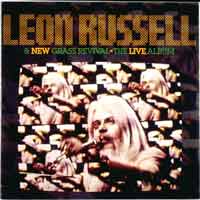 Die
Kombination aus R&B-Piano und Gesang (Leon Russell) und Bluegrass
(New Grass Revival) klingt nicht unbedingt offensichtlich. Leon Russell,
in den späten 60ern und frĂ¼hern 70ern einer der angesagtesten
Studiomusiker in L.A. und Komponist vieler Hits (z.B. "Delta Lady"
fĂ¼r Joe Cocker) wird bei diesem Clubauftritt in Pasadena von der
angesagtesten Band der aufkommenden "New Grass"-Szene unterstĂ¼tzt:
Sam Bush (Mandoline, Geige), Curtis Burch (Gitarre, Dobro),
Courtney Johnson (Banjo) und John Cowan (Bassgitarre)
spielen zwar irgendwie Bluegrass, aber eben nicht auf die traditionelle
Weise, sondern gerne in Kombination mit Reggae, Jazz und Rock. Die
Kombination aus R&B-Piano und Gesang (Leon Russell) und Bluegrass
(New Grass Revival) klingt nicht unbedingt offensichtlich. Leon Russell,
in den späten 60ern und frĂ¼hern 70ern einer der angesagtesten
Studiomusiker in L.A. und Komponist vieler Hits (z.B. "Delta Lady"
fĂ¼r Joe Cocker) wird bei diesem Clubauftritt in Pasadena von der
angesagtesten Band der aufkommenden "New Grass"-Szene unterstĂ¼tzt:
Sam Bush (Mandoline, Geige), Curtis Burch (Gitarre, Dobro),
Courtney Johnson (Banjo) und John Cowan (Bassgitarre)
spielen zwar irgendwie Bluegrass, aber eben nicht auf die traditionelle
Weise, sondern gerne in Kombination mit Reggae, Jazz und Rock.
Das komplette Konzert gibt es jetzt auch auf DVD,
wobei erst dort die starke BĂ¼hnenpräsenz von Leon Russell
richtig zur Geltung kommt.
|
| Grateful Dead: "Reckoning" (Arista, April 1981) |
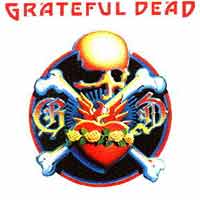 Oktober
1980 hatten sich die Dead jeweils fĂ¼r eine Woche in der New Yorker
Radio City Music Hall und im Warfield Theatre in San Francisco eingemietet
und ihre Shows in Bild und Ton festgehalten. Seit Ewigkeiten gab's auch
endlich mal wieder einen akustischen Set, in denen vor allem Songs aus
den "Country"-Alben Workingman's
Dead und American Beauty (beide
1970), sowie viele Folk- und Bluegrass-Klassiker interpretiert wurden.
Songauswahl und Besetzung (Akustikgitarren, E-Bass, FlĂ¼gel, Spinett,
Snare, Congas) machen dieses Livealbum zu einem besonderen unter den zahlreichen
Livealben der Band. Ende des Jahres erschien mit "Dead Set"
bereits das nächste Live-Doppelalbum mit dem elektrischen Teil der
Shows: fĂ¼r meinen Geschmack deshalb weit weniger interessant. Oktober
1980 hatten sich die Dead jeweils fĂ¼r eine Woche in der New Yorker
Radio City Music Hall und im Warfield Theatre in San Francisco eingemietet
und ihre Shows in Bild und Ton festgehalten. Seit Ewigkeiten gab's auch
endlich mal wieder einen akustischen Set, in denen vor allem Songs aus
den "Country"-Alben Workingman's
Dead und American Beauty (beide
1970), sowie viele Folk- und Bluegrass-Klassiker interpretiert wurden.
Songauswahl und Besetzung (Akustikgitarren, E-Bass, FlĂ¼gel, Spinett,
Snare, Congas) machen dieses Livealbum zu einem besonderen unter den zahlreichen
Livealben der Band. Ende des Jahres erschien mit "Dead Set"
bereits das nächste Live-Doppelalbum mit dem elektrischen Teil der
Shows: fĂ¼r meinen Geschmack deshalb weit weniger interessant. |
| Paul Brady: "Hard Station" (Polydor, April 1981) |
 Das SolodebĂ¼t des Iren, der frĂ¼her mal bei Planxty richtigen
"Irish Folk" spielte, hier aber als "normaler" Singer/Songwriter
in Erscheinung tritt, der sich hinter anderen irischen (Van!) und amerikanischen
Kollegen nicht zu verstecken braucht. Viele seiner Songs wurden später
von anderen KĂ¼nstlern Ă¼bernommen (Tina Turner, David Crosby, Bonnie Raitt etc.)
Das SolodebĂ¼t des Iren, der frĂ¼her mal bei Planxty richtigen
"Irish Folk" spielte, hier aber als "normaler" Singer/Songwriter
in Erscheinung tritt, der sich hinter anderen irischen (Van!) und amerikanischen
Kollegen nicht zu verstecken braucht. Viele seiner Songs wurden später
von anderen KĂ¼nstlern Ă¼bernommen (Tina Turner, David Crosby, Bonnie Raitt etc.)

 Mehr ...
Mehr ...
|
"I had been working for a decade in traditional Irish music forms
- working into an already built structure and just basically learning
how to do it. It was a lot of fun but I wanted to find something else.
'Hard Station' was my first attempt at writing and arranging my own music
and getting other people to play it as I heard it. The record itself was
started in early 1981 in the old Windmill Lane Studios in Dublin and we
recorded it over a few months.
I was equally excited and apprehensive. As a solo performer, I had been
introducing these songs acoustically from about 1979, but this was a whole
new thing. It was produced by Hugh Murphy and myself....and the band in
studio was really my first electric band - largely the same outfit I had
been touring Ireland with the previous year...Jimmy Faulkner and Arty
McGlynn on electric guitars, Fran Breen on drums, Tommy Moore on bass.
Betsy Cook, married to Hugh Murphy at the time, was a new and exciting
ingredient on keyboards and vocals.
Jimmy Faulkner's solo guitar and Betsy's piano on 'Nothing but the same
old Story' still thrill me after all this time. By now I had already released
a single version of 'Crazy Dreams' (a different recording) and it had
been a hit in Ireland. So with the tour the previous year and the fact
that basically all the songs were already known, people were waiting for
this record and it was very well received. This was a whole new beginning
for me"
(Paul Brady) |
|
| Deke Leonard: "Before Your Very Eyes" (United Artists, April 1981) |
 1976
hiess es bei Man "All's Well
That Ends Well" - und die beste walische Band gab's nicht mehr!
Deke Leonard verzagte aber nicht, sondern durfte bei der alten
Firma United Artists, die ja alle wichtigen Platten der Band von 1970-75
herausgebracht hat, ein Soloalbum beginnen. November 1977 fanden bereits
die ersten Aufnahmen statt, im April 1979 war man fertig - aber jetzt
interessierte sich dort Ă¼berhaupt niemand mehr fĂ¼r die Platte.
Es dauerte dann noch weitere zwei Jahre, bis das Album schlieĂŸlich doch
noch, zumindest in GroĂŸbritannien, herauskam: aber völlig ohne Promotion
wurde es natĂ¼rlich ein richtiger Flop! Die Platte war Mitte der 80er
bei uns auch kaum zu bekommen und von mir nur durch Zufall einmal als
teurer Import in einem Oberhausener Plattenladen entdeckt worden. 1976
hiess es bei Man "All's Well
That Ends Well" - und die beste walische Band gab's nicht mehr!
Deke Leonard verzagte aber nicht, sondern durfte bei der alten
Firma United Artists, die ja alle wichtigen Platten der Band von 1970-75
herausgebracht hat, ein Soloalbum beginnen. November 1977 fanden bereits
die ersten Aufnahmen statt, im April 1979 war man fertig - aber jetzt
interessierte sich dort Ă¼berhaupt niemand mehr fĂ¼r die Platte.
Es dauerte dann noch weitere zwei Jahre, bis das Album schlieĂŸlich doch
noch, zumindest in GroĂŸbritannien, herauskam: aber völlig ohne Promotion
wurde es natĂ¼rlich ein richtiger Flop! Die Platte war Mitte der 80er
bei uns auch kaum zu bekommen und von mir nur durch Zufall einmal als
teurer Import in einem Oberhausener Plattenladen entdeckt worden.
Die Musik? Irgendwie klingt's schon wie bei Man, bzw. Leonards "Iceberg"-Soloalben
aus den frĂ¼hen 70ern, also etwas kĂ¼rzere und eingängigere
Songs als bei Man, aber natĂ¼rlich in New-Wave-Zeiten ohne
eine kommerzielle Chance. Mit dabei als Begleitband waren die alten Kumpels
Martin Ace (Man-Bassist von 1970-72,
1975 und seit dem "Comeback" 1983), Malcolm Morley (Help
Yourself- und One-Time-Man-Keyboarder
1974) und Dave Charles (Trommler bei Help
Yourself, Iceberg und Dave
Edmunds und inzwischen Tonmeister in den legendären Rockfield-Studios
in Wales), sowie weitere Freunde mit gelegentlichen Gastbeiträgen
(Dave Edmunds, Billy Bremner, Terry Wiliams, alle
drei zu der Zeit bei Rockpile erfolgreich.) |
| James Taylor: "Daddy Loves His Work" (Columbia, April 1981) |
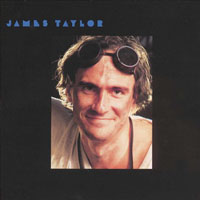 Gefunden in der Grabbelkiste!
Gefunden in der Grabbelkiste!
(22.03.2016)

 Mehr ...
Mehr ...
James Taylor bounced back from the spotty Flag with this all-original album led by his collaboration with J.D. Souther on "Her Town Too," his biggest pop hit since "Handy Man," and his biggest non-cover hit since his first, "Fire and Rain," in 1970. Also included were "Hard Times" and "Summer's Here," not to mention the unusually impassioned "Stand and Fight." After simmering this long, there wasn't much hope Taylor would ever come to a boil, but that track indicated he could at least heat up now and then.
(by Thom Jurek, All Music Guide)
|
| Echo & The Bunnymen: "Heaven Up There" (WEA/Korova, Mai 1981) |
 Die
Band ist eine der wenigen Truppen aus der "Grufty"-Ecke, die
ich klasse finde. Eigentlich ist das Etikett "Grufty"/"DĂ¼sterrock"
auch eher unpassend. Mich erinnern die Jungs viel eher an die guten alten
Doors. Produziert von Hugh Jones. Die
Band ist eine der wenigen Truppen aus der "Grufty"-Ecke, die
ich klasse finde. Eigentlich ist das Etikett "Grufty"/"DĂ¼sterrock"
auch eher unpassend. Mich erinnern die Jungs viel eher an die guten alten
Doors. Produziert von Hugh Jones. |
| Tim Hardin: "The Homecoming Concert" (Line, Mai 1981) |
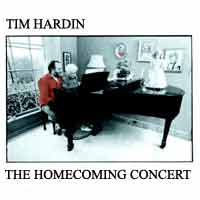 Sein letztes Konzert vom 17. Januar 1980, zu Hause in Eugene/Oregon.
Sein letztes Konzert vom 17. Januar 1980, zu Hause in Eugene/Oregon.
(05.04.2010)

 Mehr ...
Mehr ...
Tim Hardin starb am 29. 12. 1980 mit 39 Jahren, elf Monate nach diesem letzten Konzert. "Reason To Believe", "If I Were A Carpenter" und zehn weitere poetische Balladen singt er solo zu akustischer Gitarre - mit war- mem, brüchigem Timbre, bluesgetränkt. "Misty Roses" ist eins der schönsten Liebeslieder überhaupt.
(© Audio)
Er war ein früher Weggefährte von Bob Dylan, schrieb Welterfolge wie "Hang On To A Dream" und "If I Were A Carpenter" und machte alle Höhen und Tiefen einer Außenseiterexistenz als Musiker durch. Kurz bevor der kränkelnde und vereinsamte Tim Hardin 39jährig starb, gab er auf Initia- tive eines Freundes ein "Homecoming Concert" in seiner Heimatstadt im US- Bundesstaat Oregon. Alle großen Hardin-Songs sind auf diesem einmaligen Tondokument zu hören, in Folkblues-Interpretationen, die Hardins wider- borstigem Charakter in optimaler Weise entsprechen: ohne Zweifel ein Juwel im CD-Katalog von Uwe Tessnows Line-Label. LP-Kritik: Die Rarität 1/82
(© Stereoplay)
This 1980 concert would be Hardin's last, as the singer, continually beset by drug and alcohol problems, died in December of that year. The site of the performance was Hardin's hometown of Eugene, OR, to which he had returned to participate in a TV documentary about his career. From the photo on the front, it appears that time had taken its toll on Hardin, who'd been living in intentional obscurity in England for several years. Amazingly, his voice sounds clearer and purer than it did on his earliest albums. Before an appreciative hometown crowd, Hardin performs solo, delivering powerful, affecting versions of songs from his first couple of recordings. In retrospect, his eulogistic "Tribute to Hank Williams" is eerily prophetic. The sadness in Hardin's voice on the piano ballad "Hang on to a Dream" is particularly poignant, but the entire disc is eminently rewarding. It shows that Hardin, who was at work on a new album at the time of his death, was the owner of a musical fire that was still burning brightly at that late date.
|
| The Keys: "The Keys Album" (A&M, Mai 1981) |
 Mal wieder eine WĂ¼hltisch-Entdeckung! Von der Band um den Sänger/Bassisten
Drew Barfield gibt's auch nur dieses Album, wobei es sich noch
niemals um ein "One-Hit-Wonder" handelt, denn - Ihr habt es
erraten- das Album verkaufte sich kaum ("no sales") und hat
es bis heute nicht zur Wiederveröffentlichung auf CD gebracht. Dabei
ist es voll von feinstem Gitarren-Pop mit massenhaft OhrwĂ¼rmern.
Keine Ahnung, warum das damals niemand hören wollte. Ach ja - produziert
hat der damalige Label-Kollege (und Jugendfreund!) Joe Jackson,
was aber auch nichts genĂ¼tzt hat. Drew Barfield verdient seitdem
sein Geld als Chorsänger und Songschreiber fĂ¼r andere Leute,
u. a. fĂ¼r jenen Joe Jackson und Paul Young, mit dem er auch
in der Londoner Countryband Los Pacaminos (hobbymĂ¤ĂŸig?)
spielt.
Mal wieder eine WĂ¼hltisch-Entdeckung! Von der Band um den Sänger/Bassisten
Drew Barfield gibt's auch nur dieses Album, wobei es sich noch
niemals um ein "One-Hit-Wonder" handelt, denn - Ihr habt es
erraten- das Album verkaufte sich kaum ("no sales") und hat
es bis heute nicht zur Wiederveröffentlichung auf CD gebracht. Dabei
ist es voll von feinstem Gitarren-Pop mit massenhaft OhrwĂ¼rmern.
Keine Ahnung, warum das damals niemand hören wollte. Ach ja - produziert
hat der damalige Label-Kollege (und Jugendfreund!) Joe Jackson,
was aber auch nichts genĂ¼tzt hat. Drew Barfield verdient seitdem
sein Geld als Chorsänger und Songschreiber fĂ¼r andere Leute,
u. a. fĂ¼r jenen Joe Jackson und Paul Young, mit dem er auch
in der Londoner Countryband Los Pacaminos (hobbymĂ¤ĂŸig?)
spielt.
(20.02.2005)

 Mehr ...
Mehr ...
|
Drew Barfield is a singer/songwriter of impressive talent, which has
been a well-kept secret for as long as he remembers! He has used his writing
and vocal strengths to record and perform music in a variety of styles,
from glorious pop anthems to heartfelt soul classics.
Drew's early musical apprenticeship started as a soloist in church choirs,
and school operas. With his brother Dave he formed a teenage rhythm section,
often with hilarious consequences – fellow teenage musician and lifelong
friend Joe Jackson details some of the more amusing escapades in his seminal
book “A Cure For Gravity.”
During the ‘70s Drew attended Goldsmiths Art College in London and
did what all self-respecting and budding artists did – he dropped
out to form a band, John Doe. It was in this band that he first teamed
up with Gary Sanford (Joe Jackson's future Guitarist) Steve Tatler (Drew's
old song writing and later Key's cohort). However, this being less of
a band and more of an exercise in hedonism, John Doe was inevitably laid
to rest.
In 1979 Drew formed The Keys with Steve Tatler, Ben Grove, and ex-Wings
drummer Geoff Britton. They were signed to A&M records and released
“The Keys Album” to rapturous reviews but no sales!! Produced
by Joe Jackson, it contained the perfect pop songs of “One Good Reason”,
“I Don't Wanna Cry “ and “Greasy Money”, all of which
were released as singles. When The Keys split in 1983 Drew formed The
Big Heat with singer Bill Hurley (The Inmates) and guitarist Chris Parks
(Any Trouble). Big Heat's first release was the acclaimed single “Watch
Me Catch Fire” (on A&M) which was written by Drew and produced
by Elvis Costello. This looked a sure bet for some serious chart action
until The Bradford Football Stadium fire, which led BBC producers to drop
it from their playlists because of the title! How the Gods conspire against
us!!
Drew's next recording was as lead vocalist with JB's All Stars –
the JB in this case being John Bradbury, previously of The Specials. Their
recordings of the northern soul classics “Backfield in Motion”
and “One Minute Every Hour” relied heavily on Drew's vocal and
emotional range.
Throughout the ‘80s and early ‘90s Drew wrote songs or lyrics
for such diverse artists as Joe Jackson, Level 42 and Cathy Denis. Paul
Young and producer Laurie Latham chose “Standing on the Edge”
for Paul's “Secrets of Association” album. This was the start
of a professional and personal friendship with Paul. Paul went on to record
Drew's “War Games” and they collaborated on material for further
albums including “The Crossing”. The critically lauded “Paul
Young” album featured no less that 6 Barfield/Young tracks, including
the singles “Wish You Love” and “Ball and Chain” together
with the beautiful “Tularosa”.
During ths period Drew would occasionally do session singing and backing
vocals for other artists - one being Joan Armatrading - and he sang both
lead and backing vocals on Joe Jackson's album “Blaze of Glory”.
Since 1993 Drew has played in the seriously good time Tex-Mex band Los
Pacaminos. The line up also comprises Paul Young, Jamie Moses, Matt Irving,
Melvin Duffy, Steve Greatham, Mark Pinder, Jim Russell, David Levy, John
Tonks. All these guys are musicians of great pedigree having played with
the likes of Brian May (Jamie), Robbie Williams (Melvin) and Squeeze (Matt)
– do your own research on the others! Better still, go see them for
a fun night out!
Most of Drew's song demos for other artists were recorded using Chris
Parks as guitarist/keyboard/engineer. It was Chris' powers of persuasion
that has led to the album “Deep Water Terminal” reaching fruition.
Together with engineer Kevin Porée, Chris began the slow process
of once-weekly sessions at Berry St Studio, EC1, recording Drew's favourite
or most personal songs. The only cover song that they recorded is Al Green's
“Belle”, included by popular demand for all those who have seen
Drew sing it with Los Pacaminos.
With Chris' distinctive guitar work as a base, Drew coerced most members
of Los Pacaminos and some other unsuspecting talents to help record this
album as a homage to old style writing and recording values. We hope you'll
agree it's been worth it.
(www.drewbarfield.com)
|
|
| David Lindley: "El Rayo-X" (Elektra/Asylum, Mai 1981) |
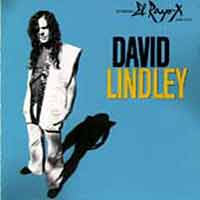 Davids SolodebĂ¼t mit seiner irren Mischung aus Jamaika (der Rhythmus)
und Hawaii (Slidegitarren!!!). Produziert hatte sein alter Chef Jackson
Browne, am Schlagzeug saĂŸ der ehemalige King
Crimson-Mann Ian Wallace. Es werden zwar fast nur Coverversionen
geboten, aber die haben es in sich: "Mercury Blues", "Twist
And Shout" etc.
Davids SolodebĂ¼t mit seiner irren Mischung aus Jamaika (der Rhythmus)
und Hawaii (Slidegitarren!!!). Produziert hatte sein alter Chef Jackson
Browne, am Schlagzeug saĂŸ der ehemalige King
Crimson-Mann Ian Wallace. Es werden zwar fast nur Coverversionen
geboten, aber die haben es in sich: "Mercury Blues", "Twist
And Shout" etc.

 Mehr ...
Mehr ...
|
"By the time David Lindley made his move to a solo career, he was
already a legend. Having toured and recorded with such names as Jackson
Browne, Linda Ronstadt, and Crosby & Nash his reputation as a multi-instrumentalist
(on almost any stringed instrument) was awesome. Lindley scored a contract
with Elektra Records and put together an excellent band that was able
to keep up with his eclectic vision. Combining blues, rock & roll,
Cajun, Zydeco, Middle Eastern music, and other elements, his debut album
is an absolute joy. Lindley's version of "Mercury Blues" became
an FM radio staple, and his slide guitar performances on this track alone
are easily some of the finest of the decade. There are some wonderfully
skewed originals on the record as well, making El Rayo-X one of the greatest
rock world music albums of its time. Fabulous." (Matthew Greenwald,
All Music Guide)
|
|
| Squeeze: "East Side Story" (A&M, Mai 1981) |
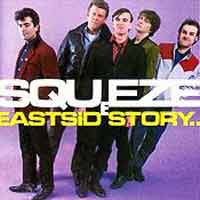 Squeeze war zwar eigentlich die Band der Sänger, Gitarristen und
Songschreiber Chris Difford und Glenn Tilbrook. Den grĂ¶ĂŸten
Hit der Band "Tempted" sang aber Paul Carrack (vormals
bei Ace, danach bei Nick
Lowe und später erfolgreich als Stimme von Mike & The
Mechanics), der nur fĂ¼r ein paar Monate hier die Tasten drĂ¼ckte.
Tempted wurde dann ein paar Jahre später noch mal von Joe "WindmĂ¼hle"
Cocker misshandelt.
Squeeze war zwar eigentlich die Band der Sänger, Gitarristen und
Songschreiber Chris Difford und Glenn Tilbrook. Den grĂ¶ĂŸten
Hit der Band "Tempted" sang aber Paul Carrack (vormals
bei Ace, danach bei Nick
Lowe und später erfolgreich als Stimme von Mike & The
Mechanics), der nur fĂ¼r ein paar Monate hier die Tasten drĂ¼ckte.
Tempted wurde dann ein paar Jahre später noch mal von Joe "WindmĂ¼hle"
Cocker misshandelt. |
| Ricky Lee Jones: "Pirates" (Warner, Juli 1981) |
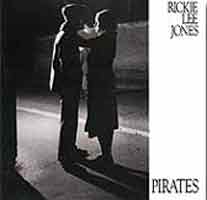 Das zweite Album dieser tollen Sängerin und Songschreiberin schlägt
glatt ihr DebĂ¼t, hat aber keinen so markanten Hit wie beim ersten Mal.
Das zweite Album dieser tollen Sängerin und Songschreiberin schlägt
glatt ihr DebĂ¼t, hat aber keinen so markanten Hit wie beim ersten Mal.
|
| "Bobby & The Midnites" (Arista, Okt. 1981) |
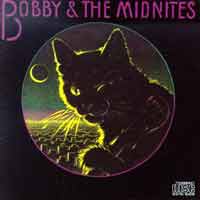 Statt
eines Soloalbums stellt der Teamplayer Bob Weir in seiner Grateful
Dead-Pause lieber wieder eine Band zusammen, in der hochkarätige
Mitspieler dabei sind: Gitarrist Bobby Cochran war mal kurz bei
Steppenwolf, Harpspieler Matt Kelly hatte bereits mit Weir
zusammen bei Kingfish gespielt,
Keyboarder Brent Mydland war vorher bei den relativ unbekannten
Westcoastrockern Silver und Ă¼bernahm auch bei Grateful
Dead diesen Job. Am prominentesten ist die Rhythmusgruppe besetzt:
Alphonso Johnson am Bass (Ex-Weather Report und Santana
in spé) und Billy Cobham
am Schlagzeug. Und trotz der Jazzer in der Rhythmusgruppe rockt es nicht
schlecht! AuĂŸerdem mĂ¼ssen die beiden wohl eine richtige Vorliebe
fĂ¼r die Musik der Dead haben, denn Jahre später haben sie sogar
mit Jazz Is Dead eine eigene
Grateful Dead-Coverband gegrĂ¼ndet! Statt
eines Soloalbums stellt der Teamplayer Bob Weir in seiner Grateful
Dead-Pause lieber wieder eine Band zusammen, in der hochkarätige
Mitspieler dabei sind: Gitarrist Bobby Cochran war mal kurz bei
Steppenwolf, Harpspieler Matt Kelly hatte bereits mit Weir
zusammen bei Kingfish gespielt,
Keyboarder Brent Mydland war vorher bei den relativ unbekannten
Westcoastrockern Silver und Ă¼bernahm auch bei Grateful
Dead diesen Job. Am prominentesten ist die Rhythmusgruppe besetzt:
Alphonso Johnson am Bass (Ex-Weather Report und Santana
in spé) und Billy Cobham
am Schlagzeug. Und trotz der Jazzer in der Rhythmusgruppe rockt es nicht
schlecht! AuĂŸerdem mĂ¼ssen die beiden wohl eine richtige Vorliebe
fĂ¼r die Musik der Dead haben, denn Jahre später haben sie sogar
mit Jazz Is Dead eine eigene
Grateful Dead-Coverband gegrĂ¼ndet!

 Mehr ...
Mehr ...
Bobby & The Midnites seemed to offer Grateful Dead guitarist Bob Weir an opportunity to pursue the more conventionally accessible pop-rock style he had first demonstrated a taste for in his '70s solo albums Ace and especially Heaven Help The Fool. With the exception of a couple of reggae numbers, The Midnites' debut album found Weir playing straight-ahead guitar rock songs with mostly lovelorn lyrics, the only real ringer in the bunch being jazz drummer Billy Cobham, who seemed capable of hitting as many drums per bar as Keith Moon, and with far more control. But Weir's earnest, husky voice and off-center guitar playing did not make for a slick pop approach, and the album came off as a collection of half-baked wannabe-hits from someone who had spent his career finding success by avoiding just such a style.
(by William Ruhlmann, All Music Guide)
|
| Elvis Costello & The Attractions: "Almost Blue" (F-Beat, Okt. 1981) |
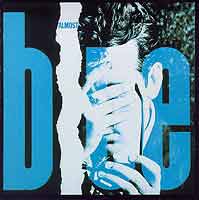 "To
release a C&W record may have been a wilful act of commercial suicide,
but for Elvis this was a very real album." "To
release a C&W record may have been a wilful act of commercial suicide,
but for Elvis this was a very real album."
Ă¼berraschenderweise brachte "A Good Year For The Roses"
Elvis zurĂ¼ck in die UK-Charts!
|
| Mink DeVille: "Coup De Grace" (Atlantic, Okt. 1981) |
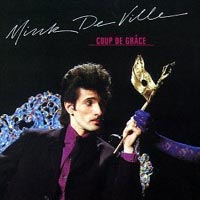 jetzt
auch in der Grabbelkiste ... jetzt
auch in der Grabbelkiste ...
(15.06.2008) |
| Japan: "Tin Drum" (Virgin, Nov. 1981) |
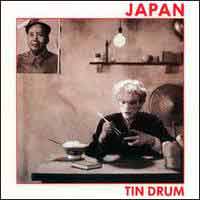 Mit
diesem Album hat sich die Band um den Sänger David
Sylvian dann endgĂ¼ltig vom Image einer Popgruppe gelöst. Mit
diesem Album hat sich die Band um den Sänger David
Sylvian dann endgĂ¼ltig vom Image einer Popgruppe gelöst. |
| Danny Adler: "Gusha-Gusha Music" (Line, 1981) |
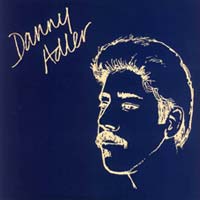 Der amerikanische Sänger, Songschreiber, Gitarrist und (leider) Schnurbartträger
hatte in den späten 70ern (mit den Pubrockern Roogalator)
und frĂ¼hen 80ern in England eine gewisse Bekanntheit erlangt, galt
sogar mal fĂ¼r einen Moment als der "neue Bruce Springsteen",
verschwand aber schnell wieder in der Versenkung. Die Musik ist eine ganz
eigentĂ¼mliche Mischung aus recht traditionellem Bluesrock mit viel
Boogie und Shuffle, aber immer wieder mit Jazz-, Funk- und Rock-, ja sogar
Latinelementen. Das Ganze nennt Herr Adler "Gusha-Gusha-Music",
war damals eine kleine musikalische Insel in schlimmen musikalischen Zeiten
und erinnert mich entfernt an eine Kreuzung aus Litle Feat (nicht
ganz so virtuos) und Dr. Feelgood (mit besseren Songs). Na ja:
der Vergleich stimmt schon irgendwie, aber hinkt auch ein wenig. Also,
liebe Leute: selber hören - falls Ihr seine Platten irgendwo in den
Grabbelkisten dieser Welt noch finden solltet!
Der amerikanische Sänger, Songschreiber, Gitarrist und (leider) Schnurbartträger
hatte in den späten 70ern (mit den Pubrockern Roogalator)
und frĂ¼hen 80ern in England eine gewisse Bekanntheit erlangt, galt
sogar mal fĂ¼r einen Moment als der "neue Bruce Springsteen",
verschwand aber schnell wieder in der Versenkung. Die Musik ist eine ganz
eigentĂ¼mliche Mischung aus recht traditionellem Bluesrock mit viel
Boogie und Shuffle, aber immer wieder mit Jazz-, Funk- und Rock-, ja sogar
Latinelementen. Das Ganze nennt Herr Adler "Gusha-Gusha-Music",
war damals eine kleine musikalische Insel in schlimmen musikalischen Zeiten
und erinnert mich entfernt an eine Kreuzung aus Litle Feat (nicht
ganz so virtuos) und Dr. Feelgood (mit besseren Songs). Na ja:
der Vergleich stimmt schon irgendwie, aber hinkt auch ein wenig. Also,
liebe Leute: selber hören - falls Ihr seine Platten irgendwo in den
Grabbelkisten dieser Welt noch finden solltet!
(02.07.2006)

 Mehr ...
Mehr ...
Following on from the exquisite Funky Afternoons, former Roogalator frontman Danny Adler's first solo album of the 1980s caught him in an unforgiving mood, driving through an album of relentless intensity, built around some of the finest songs of his career. From the opening "Solid Sender," both titled and styled after ex-Feelgoods guitarist Wilko Johnson's last band, through the wry irony of the closing "God on a Mudguard," Gusha Gusha Music is angular blues fed through the deepest boogie, which rarely loses sight of Adler's sharp eye for pop hooks. "Fantasy Pants" is Elvis Costello meets "Lipstick on Your Collar"; "Rockaround" predicts the imminent emergence of the Stray Cats et. al; "TGIF" is solid Philly soul; "Kiss It Goodbye" is the Beatles caught in the Cavern; and all building up to the frenetic final salvo of funk ("Gusha Gusha Woman"), blues ("Ghost Train Ride"), and self-fulfilling prophecy -- "The Ten Commandments of the Boogie." All of which could have emerged as an absolute mish-mash, disparate styles ricocheting off the listener's head and leaving only confusion in their wake. But Adler's vocal is the glue that binds them, and his guitar simply doesn't know when to quit, layering every song with such stylish licks and leads that he could play through every genre in the book and never give your ears a nasty jolt. Which might well be what the title phrase is getting at -- "Gusha Gusha" isn't in any dictionary you'll ever read. But one listen to this magnificent album and you'll know precisely what it means. Gusha gusha...great, great!
(by Dave Thompson, All Music Guide)
|
| Lee Clayton: "The Dream Goes On" (Capitol, 1981) |
|
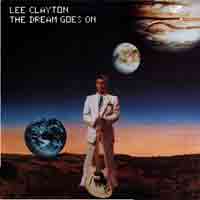 Meine
erste Lee Clayton-Platte und sein letztes Studioalbum fĂ¼r eine
sehr lange Zeit. Beeindruckend die Gitarrenarbeit von Clayton, Phil
Donnelly und Tim Krekel, die nun gar nichts mehr mit dem
Ă¼blichen Nashvillesound zu tun hatte. Meine
erste Lee Clayton-Platte und sein letztes Studioalbum fĂ¼r eine
sehr lange Zeit. Beeindruckend die Gitarrenarbeit von Clayton, Phil
Donnelly und Tim Krekel, die nun gar nichts mehr mit dem
Ă¼blichen Nashvillesound zu tun hatte.
Dieses Album war damals in meinem Freundeskreis erstaunlich beliebt,
obwohl wir zu der Zeit alle eigentlich nix mit Countryrock und Singer/Songwriter-Musik
zu tun hatten. Im Ohr ist mir immer noch die Nummer "Oh How Lucky
I Am" mit dem Kinderchor und der wunderschönen Textzeile "Eternity
- Two - Three - Four - Five".
|
| Cold Chisel: "Swingshift" (Line, 1981) |
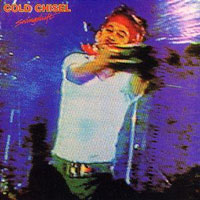 In
ihrer australischen Heimat waren sie eine groĂŸe Nummer, bei uns
kannte sie kaum jemand. Dieses Live-Doppelalbum ist wirklich amtlich -
ich kenne kaum ein besseres aus der Sparte "Mainstream-Rock". In
ihrer australischen Heimat waren sie eine groĂŸe Nummer, bei uns
kannte sie kaum jemand. Dieses Live-Doppelalbum ist wirklich amtlich -
ich kenne kaum ein besseres aus der Sparte "Mainstream-Rock".
(04.10.2016)

 Mehr ...
Mehr ...
June through August of 1980 saw Cold Chisel take to the road for its hugely successful "Youth in Asia" tour of Australia. The band was at the peak of its powers and launching from all silos, and it shows on this 17-track, two-disc set, recorded at the Capitol Theatre in Sydney on August 29 and 30. Producer Mark Opitz, who felt this was the best of the Chisel albums he'd worked on, claimed that he didn't put in a single overdub -- a clear indication of how hot the band's chops were. Cold Chisel was touring in support of its newly released breakthrough album, East, which had burned up the Aussie charts in short order, and seven of that disc's songs are performed here. Highlights from Chisel's first two studio albums are also featured, as well as three covers, including a blazing rendition of the Jerry Lee Lewis standard "Don't Let Go" and Creedence Clearwater Revival's "Long as I Can See the Light." The only question mark in the set is the inclusion of Bob Dylan's "Knockin' on Heaven's Door" -- a song the Chisels always seemed to enjoy playing. Though proficiently delivered, it's an unnecessary, oversized bite. But then again, when your stocks are soaring you can afford to indulge yourself a little. Seven of the numbers on Swingshift also appear on Cold Chisel's farewell live album, Last Stand, but there's no redundancy in these snapshots from different eras. Highlights are many, but it's hard to go past the band's signature number "Khe Sanh," the dark and frantic "Conversations," the beefed-up rockabilly of "Rising Sun," and the rock & roll meteor "Goodbye (Astrid Goodbye)." Great support work from saxophonist Billy Rodgers and harmonica player Dave Blight add extra spice to several of the songs. Swingshift was an instant number one, platinum-certified hit in Australia, further enlarging the Cold Chisel aura. As for the album title, the band claimed it was a reference to the midnight-to-dawn shift that staff in mental asylums dread: the hours when the crazies go crazy. Somehow that seems very apt for these wild colonial boys.
(by Adrian Zupp, All Music Guide)
|
| Rodney Crowell (Warner, 1981) |
 "Almost
every track on here is catchy, easy on the ears, and memorable. A couple
of mildly grating detours into rockabilly turf stand at odds with Crowell's
sleek poetic streak (notably a misguided flogging of Moon Mullican's "Pipeliner
Blues"), but with a battery of great tunes like "Stars On The
Water", "Only Two Hearts" and "Only Two Hearts"
to hum along to, what's there to complain about, really? Bob Seger had
a hit covering "Shame on the Moon," which I always thought showed
remarkably good taste on his part -- it's a really great song. Even two-chord
R&B dorkfest anthems like "Don't Need No Other Now" and
"All You've Got to Do" are fun to sing along with when the neighbors
are out of town..." "Almost
every track on here is catchy, easy on the ears, and memorable. A couple
of mildly grating detours into rockabilly turf stand at odds with Crowell's
sleek poetic streak (notably a misguided flogging of Moon Mullican's "Pipeliner
Blues"), but with a battery of great tunes like "Stars On The
Water", "Only Two Hearts" and "Only Two Hearts"
to hum along to, what's there to complain about, really? Bob Seger had
a hit covering "Shame on the Moon," which I always thought showed
remarkably good taste on his part -- it's a really great song. Even two-chord
R&B dorkfest anthems like "Don't Need No Other Now" and
"All You've Got to Do" are fun to sing along with when the neighbors
are out of town..." |
| Doll By Doll (Magnet, 1980/81) |
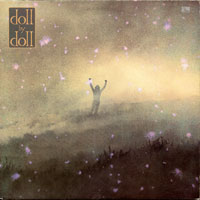 Das titellose dritte Album einer der unterbewertetsten Band aus dieser
merkwĂ¼rdigen Zeit. Je nach Quelle erst 1981 oder bereits 1980 veröffentlicht.
Der Sound vom Vorgänger "Gypsy
Blood" wurde weiter verfeinert, man wechselte von einer obskuren
Majorfirma (Automatic) zur nächsten (von den Magnet-KĂ¼nstlern
kenne ich sonst nur noch Chris Rea), hatte einen neuen Produzenten: statt
Bill Price war jetzt der durch Mike Oldfields frĂ¼he
Alben zu Ruhm (und Geld?) gekommene Tom Newman dabei. Jackie
Levens Gesang wird immer besser (und exzentrischer!), Klassegitarrist
Jo Shaw setzt auch eine Mandoline ein (und das zu new Wave-Zeiten!),
Trommler David McIntosh spielt sogar Marimbaphon. Aber es hat alles
nichts genĂ¼tzt: im Prinzip war die Band - zumindest in dieser Form-
aufgrund von Erfolglosigkeit (auĂŸer bei Hardcore-Fans) und ohne breite
PresseunterstĂ¼tzung am Ende. Es folgt zwar noch ein weiteres Album
von Jackie Leven mit anderen Musikern unter diesem Namen - aber das war
es dann. Und es gibt immer noch keine CD-Veröffentlichung. Da hilft
nur Selbstgebranntes!!!
Das titellose dritte Album einer der unterbewertetsten Band aus dieser
merkwĂ¼rdigen Zeit. Je nach Quelle erst 1981 oder bereits 1980 veröffentlicht.
Der Sound vom Vorgänger "Gypsy
Blood" wurde weiter verfeinert, man wechselte von einer obskuren
Majorfirma (Automatic) zur nächsten (von den Magnet-KĂ¼nstlern
kenne ich sonst nur noch Chris Rea), hatte einen neuen Produzenten: statt
Bill Price war jetzt der durch Mike Oldfields frĂ¼he
Alben zu Ruhm (und Geld?) gekommene Tom Newman dabei. Jackie
Levens Gesang wird immer besser (und exzentrischer!), Klassegitarrist
Jo Shaw setzt auch eine Mandoline ein (und das zu new Wave-Zeiten!),
Trommler David McIntosh spielt sogar Marimbaphon. Aber es hat alles
nichts genĂ¼tzt: im Prinzip war die Band - zumindest in dieser Form-
aufgrund von Erfolglosigkeit (auĂŸer bei Hardcore-Fans) und ohne breite
PresseunterstĂ¼tzung am Ende. Es folgt zwar noch ein weiteres Album
von Jackie Leven mit anderen Musikern unter diesem Namen - aber das war
es dann. Und es gibt immer noch keine CD-Veröffentlichung. Da hilft
nur Selbstgebranntes!!!
(02.05.2006)

 Mehr ...
Mehr ...
|
“I put a penny in the toilet door
then I quickly stepped inside
to some graffiti and a greyhound paper
and the gentle thought of suicide
a razor blade would make the perfect bride.”
Unlike the sixth song on ‘Doll By Doll’ (first track on the
second side of the vinyl release), “perfect romances” and revisited
memories rarely live up to our expectations. Recordings unheard for 25
years usually amass a kind of mental hyperbole in the interim; a promise
no revisit can fulfil. Having built up the album in my mind, I feared
that this might be the case with ‘Doll By Doll’ but, after repeated
listens over the last few days, although I can scarcely believe it, it
actually exceeds my expectations. And one song is so stellar I’d
go so far as to say that it represents the finest few minutes of pop I’ve
ever heard by anyone, ever.
There always seemed to be something subterranean about Doll By Doll;
as though a secret network of subversives existed to mould their image,
design their record covers and promote their appearances — in fact,
it did, and they called it Hard Ventures, back in the glory days when
they were the special guests of acts such as Devo at the Hammersmith Odeon.
But apparently it was a venture too hard ensuring that anything other
than a single rough diamond remains of Doll By Doll’s recorded legacy.
Hardly any of their songs can be judged by members of the public, unless
they’re prepared to go to the same trouble and expense I’ve
just endured.
The Perfect Romance from the band’s self-titled 1981 album presaged
a challenging period in the life of its Romany-Scottish singer and frontman,
Jackie Leven. As his biography on the unofficial website has it:
After a late night recording session for a solo album due for release
by Charisma/ Virgin (1983) Jackie was the subject of an unprovoked street
attack during which he, along with other injuries, was nearly murdered
by strangulation. Unable to speak or sing, he lost his record deal, friends
and way, entering his own period of psychic disorder, taking heroin (the
classic drug of despair) and living in isolation for nearly a year.
He re-joined the world in 1985 after a successful course of traditional
Chinese five-element acupuncture and psychic healing, and co-founded The
CORE Trust — ‘an holistic approach to addiction’. To this
day the trust operates a centre in central London, working with people
with all forms of addiction. Jackie has been their manager, chair of trustees,
and is presently the patron, having at one time enjoyed a good working
relationship with the late Princess Of Wales, who took a strong interest
in the Trust. During one encounter with HRH, she said to him, “I
understand you used to be a singer.”
“I am a singer,” was his bristling reply.
“Well, sing something now,” she suggested.
That something was the traditional Scottish air The Bonnie Earl Of Moray
which had formed the basis of his celebrated Doll By Doll song, Main Travelled
Roads.
Although recorded in 1980, in a Maida Vale basement, using a mobile studio,
‘Doll By Doll’ sounds as original today as it did when it was
first released. And it hasn’t dated because it wasn’t produced
with the aim of being fashionable in the first place. ‘Wild’
Tom Newman (the co-producer of Mike Oldfield’s original ‘Tubular
Bells’, and of ‘Doll By Doll’ with Leven) created a crystal-clear
soundscape of crisp, rumbling basses and rippling trebles, blending to
form an atmosphere of electrical energy. The wimpy 1980s’ mid-range
frequencies, later beloved by Duran Duran and the New Romantics, were
eschewed in favour of a crystalline hardness; and yet the result sounds
remarkably balanced.
Figure It Out, with its Stones-ish rhythm guitar touches and derisive
tone, is a noble pop song but probably shouldn’t have been the album
opener; that they took the risk is proof the music industry was a different,
not-yet-extinct animal in the 1980s. Leven’s voice, it has to be
said, is characteristically huge from the very first note and lends his
lyrics the right tone of biting sarcasm. But if I’d had to choose
the opener it would have been the next song, Caritas.
Caritas represents the closest I’m ever likely to get to hearing
perfection in songwriting and recording. A special extended version was
released as a 12-inch single, backed with Murder on the Highway (3’25”)
and An Honest Woman (8’44”), the latter recorded live in June
1981 at Richard Branson’s Venue on London’s Victoria Street.
It should have been a top 10 hit at least. Of course, there’s never
been justice in pop music, and I’m sure BBC Radio One’s producers
didn’t know what to make of it. From the first, angry notes of guitar
feedback to its crunch ending, this is what yearning, terror and beauty
in music are all about. Leven’s voice is edged with threat, and the
phased guitar arpeggio that builds out of the intro; the trebly chopped
funk chords; and Tony Waite’s ribcage-rattling bass provide the impetus
that drive Caritas forward. But it’s Jo(e) Shaw’s overdriven
lead guitar that steals the show. His mainly low- and mid-register guitar
solo is thoughtful and doesn’t noodle. But he saves his best for
the lick 02’26” into the song, between the fifth and sixth of
the short, three-line verses. In context, the most beautiful two seconds
in all of pop music come after the line: “…the blue jets scream
into the sky.
“Sing it to me now…
Caritas.”
Not only is the impossibly fast, stuttered “now” Jackie’s,
but also the swirling falsetto background vocals; highlighting the sheer
range of his voice before his larynx was crushed in the assault. At 04’15”,
this is on the long side for a pop masterpiece, but since it received
hardly any radio airplay at the time it was released, that’s irrelevant.
Soon New Life starts pensively, with a tentative, melodic bass before
a calypso guitar transforms it into a celebration of coming fatherhood.
It wouldn’t surprise me to discover Jackie can no longer listen to
this song. As he explains on the liner notes to his album ‘The Argyll
Cycle – Volume One’, at the time of recording it, not only was
he about to experience near murder by strangulation and symptomatic heroin
addiction, the love of his life was about to run off with the Dalai Lama’s
bodyguard. The chant-like chorus line of this song seems to repeat “Since
you left”, and not the song’s title; this album predates much
of Jackie’s misery, but so many of the lyrical ideas seem to prophesy
it that the entire album may feel to him like some dreadful form of alternative
therapy.
You can hear faint echoes of the next song, and the traditional melody
upon which it’s based (the one he sung for Diana), in many of Leven’s
later tunes; not least My Spanish Dad from 2001’s ‘Creatures
of Light and Darkness’ and Classicnortherndiversions from 2003’s
‘Shining Brother Shining Sister’. But Main Travelled Roads is
the source at its purest. When Jackie’s voice gets down and dirty
for the third verse the melody comes into its heartbreaking own, and he
hits some high notes that seem unlikely after you’ve heard him hit
the lower ones.
The Perfect Romance strikes up harmlessly enough. But again, Tony Waite’s
bass impels this short (03’14”) track forwards, and it’s
undoubtedly the darkest and most dangerous song on the record. The chorus
is wondrously debauched; Leven sounds like a crazed Scottish laird serenading
his ghost bride amidst the wreckage of a bacchanalian feast. Only Nick
Cave gets darker, but Jackie out-sings him, out-baritones him and out-mans
him.
The intro to I Never Saw The Movie is redolent of a hobo plucking a guitar
in railroad car, but thudding bass and howling bottleneck soon put paid
to that. The glorious bridge (“I was so dazed / I should have been
praised / I will never feel that beautiful again”), the rumbling
false-ending and consequent fade-in prevent you from dismissing this as
an insubstantial pop tune built around a catchy chorus.
Up is as advertised; from its claps, finger-clicks and chiming harmonics
to its rowdy, shouted “I wanna be up / Don’t wanna be down again”
chorus, pre-dating Chumbawamba’s Tubthumping by at least 15 years.
Shaw turns in a lovely piece of 1950s-style rock ‘n’ roll guitar
before the song turns full circle for the chiming simplicity of its ending.
There are three absolute standout tracks on ‘Doll By Doll’:
Caritas, The Perfect Romance and A Bright Green Field. And if you remain
unmoved by the latter, you have no pulse, no blood coursing through your
veins, no soul. Waite’s bottom-E rattles your skeleton, but this
is Leven’s five minutes and thirteen seconds to shine, and he’s
incandescent. Listen to the supernaturally intense way in which he stretches
the notes on the word “rain” and “sand”. The dexterity,
range and sheer variety of his vocal is mind-boggling, and the lyrical
imagery — with its centaurs, demons and holy wine — gives him
plenty of room to manoeuvre. He sounds possessed and extrapolates every
note beyond its comfort zone. (Towards the end, there’s a brief drop-out
in Vinyl Revolution’s CD, perhaps caused by a bad scratch on the
vinyl — the only imperfection on an otherwise pristine re-issue of
a British pop-rock classic.)
The darkness that characterised Doll By Doll was of a different order
from that conjured up by their west London contemporaries Killing Joke;
it’s less demonic, less gothic and more humane. Leven slept rough
and lived in squats through much of the 1960s and 1970s, and his encounters
with damaged souls can’t help but have affected his songwriting.
And yet, despite the fortress of sullenness that Doll By Doll constructed
around themselves, this is a remarkably cheerful album. The contrast between
light and dark is never over-done and no emotion is oversold. Each note
has been agonised over without any sense of the spontaneity having been
lost.
Twenty-five years on, it’s clear what a brave band this was; recording
for an uncompromisingly commercial label, the musicians and producer stuck
to their guns, made an intelligent record with an unmistakeable identity
and a recognisable sound, only to be punished by a cloth-eared industry
that didn’t know where to put anyone who defied pigeonholing. I defy
you to find a more cohesive and satisfying record.
“The last four men were waiting
for their call to take the stage
and when the curtains opened
they stood like lovers in a cage
the crowd in perfect silence
closed their eyes to hide their shame
the dressing rooms are empty
and nobody is to blame.”
(Lyrics © Jackie Leven, published by Chappell and Co.)
(Chris Bell, Neuseeland, 2005, www.nzbc.net.nz)
|
|
| Merle Haggard: "Big City" (Epic, 1981) |
 "BIG
CITY was Merle Haggard's 47th album, including Greatest Hits compilations;
it was also his Epic Records debut. An emotionally charged, crying-in-your-beer
country album full of tales of heartache, pain, and troubles, Merle speaks
from what seems to be experience. Honest, blue collar, and topped off
with well-thought lyrics that are just as gripping as the captivating
music itself, BIG CITY is one wallop of a country album sure to make you
sing, cry, and think about your life."(Alex Steininger) "BIG
CITY was Merle Haggard's 47th album, including Greatest Hits compilations;
it was also his Epic Records debut. An emotionally charged, crying-in-your-beer
country album full of tales of heartache, pain, and troubles, Merle speaks
from what seems to be experience. Honest, blue collar, and topped off
with well-thought lyrics that are just as gripping as the captivating
music itself, BIG CITY is one wallop of a country album sure to make you
sing, cry, and think about your life."(Alex Steininger) |
| Garland Jeffreys: "Escape Artist" (Epic, 1981) |
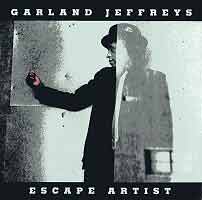 Garland
Jeffreys mit einem tollen Album, das ich in einem Duisburger Plattenladen
fĂ¼r ca. 3 DM aus dem WĂ¼hltisch gezogen habe. Garland schreibt
selber ziemlich gute Songs, trotzdem fällt vor allem die Coverversion
von "96 Tears" von Question Mark & The Mysterians
auf. Mit den Rusty Nails haben wir dann quasi diese Coverversion
auf unserer DebĂ¼t-EP noch mal gecovert. Auch wenn das Namedropping
Garland Jeffreys beim Plattenverkauf nix genĂ¼tzt hat, hier eine kurze
Auswahl der beteiligten Musiker: Linton Kwesi Johnson, Lou Reed,
David Johanson (New York Dolls), Nona Hendryx (La Belle),
Steve Goulding & Andy Bodnar (Graham Parker & The
Rumour), die Brecker Brothers, Danny Federici & Roy
Bittan (Bruce Springsteen's E-Street Band) etc. Garland
Jeffreys mit einem tollen Album, das ich in einem Duisburger Plattenladen
fĂ¼r ca. 3 DM aus dem WĂ¼hltisch gezogen habe. Garland schreibt
selber ziemlich gute Songs, trotzdem fällt vor allem die Coverversion
von "96 Tears" von Question Mark & The Mysterians
auf. Mit den Rusty Nails haben wir dann quasi diese Coverversion
auf unserer DebĂ¼t-EP noch mal gecovert. Auch wenn das Namedropping
Garland Jeffreys beim Plattenverkauf nix genĂ¼tzt hat, hier eine kurze
Auswahl der beteiligten Musiker: Linton Kwesi Johnson, Lou Reed,
David Johanson (New York Dolls), Nona Hendryx (La Belle),
Steve Goulding & Andy Bodnar (Graham Parker & The
Rumour), die Brecker Brothers, Danny Federici & Roy
Bittan (Bruce Springsteen's E-Street Band) etc. |
| Junior Wells: "Pleading The Blues" (Isabel, 1981) |
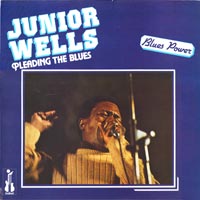 Am 31.10.1979 wurde an einem einzigen Tag in einem Studio in der französischen
Stadt Toulouse eines meiner liebsten Alben von Junior Wells live aufgenommen.
Begleitet wurde er an der Sologitarre von Buddy Guy, seinem alten
Partner aus den 60ern, und dessen Band mit Phil Guy an der funky
Rhythmusgitarre und der virtuosen Rhythmusgruppe, bestehend aus J.
Williams am Bass und Roy Allison am Schlagzeug.
Am 31.10.1979 wurde an einem einzigen Tag in einem Studio in der französischen
Stadt Toulouse eines meiner liebsten Alben von Junior Wells live aufgenommen.
Begleitet wurde er an der Sologitarre von Buddy Guy, seinem alten
Partner aus den 60ern, und dessen Band mit Phil Guy an der funky
Rhythmusgitarre und der virtuosen Rhythmusgruppe, bestehend aus J.
Williams am Bass und Roy Allison am Schlagzeug.
(13.07.2008)

 Mehr ...
Mehr ...
Man schrieb das Jahr 1959. Der Anlass war ein Blueswettkampf ('Battle of the Blues') im Blue Flame Club in Chicago. Ein junger Mundharmonikaspieler namens Junior Wells – der 1952 als Ersatz für Little Walter Jacobs in Muddy Waters Band begonnen hatte – ging wahrscheinlich nicht davon aus, dass er auf dem zweiten Platz landen würde. Schließlich hatte er bereits sowohl Otis Rush als auch Magic Sam überflügelt. Aber dann kam dieser dünne junge Kerl aus Louisiana mit seinen fliegenden Fingern an die Reihe – Buddy Guy, der es auf den ersten Platz schaffte. Auf dem Höhepunkt seines mörderischen Solos warf Guy seine Gitarre in die Luft und fing sie am Hals wieder auf - mit nur einer Hand. Während dieser durch seine Finger glitt, erzeugte Buddy mit seiner Gitarre eine Art volltönenden Seufzer. Die Menge spielte verrückt. Es war der Anfang einer wunderbaren Freundschaft. Mit dieser zufälligen Begegnung begann mehr als eine Partnerschaft. Dieser frühe und tiefe Respekt übertrug sich auf eine Beziehung, die in gewisser Weise Wells frühe Aufnahmen durch die Arbeit mit einem der wichtigsten Leute im Bereich des Blues verbesserte. Wells und Guy haben in der Folge einige der unerschrockensten und echt coolen West Side Bluesaufnahmen produziert. Dieses Album, das 1979 für das französische Label Isabel aufgenommen wurde, ist ein Pendant zu Guys Aufnahme “Blues Giant” aus demselben Jahr. Einer der Höhepunkte ist der sanfte Blues “It Hurts Me Too”, der durch Elmore James berühmt wurde. Dann ist da noch der kraftstrotzende elektrische Blues des Titelstücks und zu guter letzt als Bonustrack das funkige, deutlich von James Brown beeinflusste “I Smell Something”. Dies ist eine wunderbare Aufnahme – mit Sicherheit eine von Wells' besten weniger bekannten Veröffentlichungen.
Recorded on Halloween night in 1979, this pairs up Wells and Guy in a fashion that hasn't been heard since Hoodoo Man Blues, their first, and best collaboration. Solid backing by the Philip Guy band (Buddy's brother) makes this album a rare treat.
(by Cub Koda, All Music Guide)
|
| Jesse Winchester: "Talk Memphis" (Bearsville, 1981) |
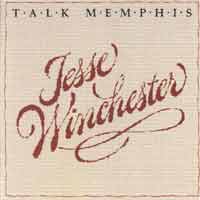 Der
Name Jesse Winchester war mir damals nur als Autor von Coverversionen
anderer KĂ¼nstler ganz vage präsent, als ich dieses Album Mitte
der 80er fĂ¼r Kleingeld aus einer Grabbelkiste gezogen habe und sofort
begeistert war. "Talk Memphis" ist wörtlich zu nehmen,
denn produziert wurde in Memphis von Produzentenlegende Willie Mitchell
(Al Green). Ein tolle Verquickung
von Singer/Songwriter-Folkrock und Memphis-Soul. Der
Name Jesse Winchester war mir damals nur als Autor von Coverversionen
anderer KĂ¼nstler ganz vage präsent, als ich dieses Album Mitte
der 80er fĂ¼r Kleingeld aus einer Grabbelkiste gezogen habe und sofort
begeistert war. "Talk Memphis" ist wörtlich zu nehmen,
denn produziert wurde in Memphis von Produzentenlegende Willie Mitchell
(Al Green). Ein tolle Verquickung
von Singer/Songwriter-Folkrock und Memphis-Soul. |
![]() Das Album des Jahres
Das Album des Jahres weitere Highlights ...
weitere Highlights ...  Mit
dieser Platte der australischen Saints als Katalognummer "Rose 1"
startete das berĂ¼hmte französische Independentlabel New Rose,
benannt nach einem Song der englischen Punkband The Damned. Die
Saints begannen ihre Karriere in der Londoner Punkszene, damals noch mit
dem Gitarristen Ed Kuepper. Der Sänger Chris Bailey
war aber einzige Konstante in den verschiedenen Besetzungen der Band.
Optisch sahen sie nie nach Punk aus und musikalisch hatten sie sich zu
einem rauen kraftvollen Rock weiterentwickelt, den man kaum noch als Punk
bezeichnen konnte.
Mit
dieser Platte der australischen Saints als Katalognummer "Rose 1"
startete das berĂ¼hmte französische Independentlabel New Rose,
benannt nach einem Song der englischen Punkband The Damned. Die
Saints begannen ihre Karriere in der Londoner Punkszene, damals noch mit
dem Gitarristen Ed Kuepper. Der Sänger Chris Bailey
war aber einzige Konstante in den verschiedenen Besetzungen der Band.
Optisch sahen sie nie nach Punk aus und musikalisch hatten sie sich zu
einem rauen kraftvollen Rock weiterentwickelt, den man kaum noch als Punk
bezeichnen konnte.  Oktober
1980 hatten sich die Dead jeweils fĂ¼r eine Woche in der New Yorker
Radio City Music Hall und im Warfield Theatre in San Francisco eingemietet
und ihre Shows in Bild und Ton festgehalten. Seit Ewigkeiten gab's auch
endlich mal wieder einen akustischen Set, in denen vor allem Songs aus
den "Country"-Alben Workingman's
Dead und American Beauty (beide
1970), sowie viele Folk- und Bluegrass-Klassiker interpretiert wurden.
Songauswahl und Besetzung (Akustikgitarren, E-Bass, FlĂ¼gel, Spinett,
Snare, Congas) machen dieses Livealbum zu einem besonderen unter den zahlreichen
Livealben der Band. Ende des Jahres erschien mit "Dead Set"
bereits das nächste Live-Doppelalbum mit dem elektrischen Teil der
Shows: fĂ¼r meinen Geschmack deshalb weit weniger interessant.
Oktober
1980 hatten sich die Dead jeweils fĂ¼r eine Woche in der New Yorker
Radio City Music Hall und im Warfield Theatre in San Francisco eingemietet
und ihre Shows in Bild und Ton festgehalten. Seit Ewigkeiten gab's auch
endlich mal wieder einen akustischen Set, in denen vor allem Songs aus
den "Country"-Alben Workingman's
Dead und American Beauty (beide
1970), sowie viele Folk- und Bluegrass-Klassiker interpretiert wurden.
Songauswahl und Besetzung (Akustikgitarren, E-Bass, FlĂ¼gel, Spinett,
Snare, Congas) machen dieses Livealbum zu einem besonderen unter den zahlreichen
Livealben der Band. Ende des Jahres erschien mit "Dead Set"
bereits das nächste Live-Doppelalbum mit dem elektrischen Teil der
Shows: fĂ¼r meinen Geschmack deshalb weit weniger interessant. Das SolodebĂ¼t des Iren, der frĂ¼her mal bei Planxty richtigen
"Irish Folk" spielte, hier aber als "normaler" Singer/Songwriter
in Erscheinung tritt, der sich hinter anderen irischen (Van!) und amerikanischen
Kollegen nicht zu verstecken braucht. Viele seiner Songs wurden später
von anderen KĂ¼nstlern Ă¼bernommen (Tina Turner, David Crosby, Bonnie Raitt etc.)
Das SolodebĂ¼t des Iren, der frĂ¼her mal bei Planxty richtigen
"Irish Folk" spielte, hier aber als "normaler" Singer/Songwriter
in Erscheinung tritt, der sich hinter anderen irischen (Van!) und amerikanischen
Kollegen nicht zu verstecken braucht. Viele seiner Songs wurden später
von anderen KĂ¼nstlern Ă¼bernommen (Tina Turner, David Crosby, Bonnie Raitt etc.)
 Mehr ...
Mehr ...
 1976
hiess es bei Man "All's Well
That Ends Well" - und die beste walische Band gab's nicht mehr!
Deke Leonard verzagte aber nicht, sondern durfte bei der alten
Firma United Artists, die ja alle wichtigen Platten der Band von 1970-75
herausgebracht hat, ein Soloalbum beginnen. November 1977 fanden bereits
die ersten Aufnahmen statt, im April 1979 war man fertig - aber jetzt
interessierte sich dort Ă¼berhaupt niemand mehr fĂ¼r die Platte.
Es dauerte dann noch weitere zwei Jahre, bis das Album schlieĂŸlich doch
noch, zumindest in GroĂŸbritannien, herauskam: aber völlig ohne Promotion
wurde es natĂ¼rlich ein richtiger Flop! Die Platte war Mitte der 80er
bei uns auch kaum zu bekommen und von mir nur durch Zufall einmal als
teurer Import in einem Oberhausener Plattenladen entdeckt worden.
1976
hiess es bei Man "All's Well
That Ends Well" - und die beste walische Band gab's nicht mehr!
Deke Leonard verzagte aber nicht, sondern durfte bei der alten
Firma United Artists, die ja alle wichtigen Platten der Band von 1970-75
herausgebracht hat, ein Soloalbum beginnen. November 1977 fanden bereits
die ersten Aufnahmen statt, im April 1979 war man fertig - aber jetzt
interessierte sich dort Ă¼berhaupt niemand mehr fĂ¼r die Platte.
Es dauerte dann noch weitere zwei Jahre, bis das Album schlieĂŸlich doch
noch, zumindest in GroĂŸbritannien, herauskam: aber völlig ohne Promotion
wurde es natĂ¼rlich ein richtiger Flop! Die Platte war Mitte der 80er
bei uns auch kaum zu bekommen und von mir nur durch Zufall einmal als
teurer Import in einem Oberhausener Plattenladen entdeckt worden.  Gefunden in der Grabbelkiste!
Gefunden in der Grabbelkiste!
 Mehr ...
Mehr ...
 Die
Band ist eine der wenigen Truppen aus der "Grufty"-Ecke, die
ich klasse finde. Eigentlich ist das Etikett "Grufty"/"DĂ¼sterrock"
auch eher unpassend. Mich erinnern die Jungs viel eher an die guten alten
Doors. Produziert von Hugh Jones.
Die
Band ist eine der wenigen Truppen aus der "Grufty"-Ecke, die
ich klasse finde. Eigentlich ist das Etikett "Grufty"/"DĂ¼sterrock"
auch eher unpassend. Mich erinnern die Jungs viel eher an die guten alten
Doors. Produziert von Hugh Jones. Sein letztes Konzert vom 17. Januar 1980, zu Hause in Eugene/Oregon.
Sein letztes Konzert vom 17. Januar 1980, zu Hause in Eugene/Oregon. Mehr ...
Mehr ...
 Mal wieder eine WĂ¼hltisch-Entdeckung! Von der Band um den Sänger/Bassisten
Drew Barfield gibt's auch nur dieses Album, wobei es sich noch
niemals um ein "One-Hit-Wonder" handelt, denn - Ihr habt es
erraten- das Album verkaufte sich kaum ("no sales") und hat
es bis heute nicht zur Wiederveröffentlichung auf CD gebracht. Dabei
ist es voll von feinstem Gitarren-Pop mit massenhaft OhrwĂ¼rmern.
Keine Ahnung, warum das damals niemand hören wollte. Ach ja - produziert
hat der damalige Label-Kollege (und Jugendfreund!) Joe Jackson,
was aber auch nichts genĂ¼tzt hat. Drew Barfield verdient seitdem
sein Geld als Chorsänger und Songschreiber fĂ¼r andere Leute,
u. a. fĂ¼r jenen Joe Jackson und Paul Young, mit dem er auch
in der Londoner Countryband Los Pacaminos (hobbymĂ¤ĂŸig?)
spielt.
Mal wieder eine WĂ¼hltisch-Entdeckung! Von der Band um den Sänger/Bassisten
Drew Barfield gibt's auch nur dieses Album, wobei es sich noch
niemals um ein "One-Hit-Wonder" handelt, denn - Ihr habt es
erraten- das Album verkaufte sich kaum ("no sales") und hat
es bis heute nicht zur Wiederveröffentlichung auf CD gebracht. Dabei
ist es voll von feinstem Gitarren-Pop mit massenhaft OhrwĂ¼rmern.
Keine Ahnung, warum das damals niemand hören wollte. Ach ja - produziert
hat der damalige Label-Kollege (und Jugendfreund!) Joe Jackson,
was aber auch nichts genĂ¼tzt hat. Drew Barfield verdient seitdem
sein Geld als Chorsänger und Songschreiber fĂ¼r andere Leute,
u. a. fĂ¼r jenen Joe Jackson und Paul Young, mit dem er auch
in der Londoner Countryband Los Pacaminos (hobbymĂ¤ĂŸig?)
spielt. Mehr ...
Mehr ...
 Davids SolodebĂ¼t mit seiner irren Mischung aus Jamaika (der Rhythmus)
und Hawaii (Slidegitarren!!!). Produziert hatte sein alter Chef Jackson
Browne, am Schlagzeug saĂŸ der ehemalige King
Crimson-Mann Ian Wallace. Es werden zwar fast nur Coverversionen
geboten, aber die haben es in sich: "Mercury Blues", "Twist
And Shout" etc.
Davids SolodebĂ¼t mit seiner irren Mischung aus Jamaika (der Rhythmus)
und Hawaii (Slidegitarren!!!). Produziert hatte sein alter Chef Jackson
Browne, am Schlagzeug saĂŸ der ehemalige King
Crimson-Mann Ian Wallace. Es werden zwar fast nur Coverversionen
geboten, aber die haben es in sich: "Mercury Blues", "Twist
And Shout" etc.
 Mehr ...
Mehr ...
 Squeeze war zwar eigentlich die Band der Sänger, Gitarristen und
Songschreiber Chris Difford und Glenn Tilbrook. Den grĂ¶ĂŸten
Hit der Band "Tempted" sang aber Paul Carrack (vormals
bei Ace, danach bei Nick
Lowe und später erfolgreich als Stimme von Mike & The
Mechanics), der nur fĂ¼r ein paar Monate hier die Tasten drĂ¼ckte.
Tempted wurde dann ein paar Jahre später noch mal von Joe "WindmĂ¼hle"
Cocker misshandelt.
Squeeze war zwar eigentlich die Band der Sänger, Gitarristen und
Songschreiber Chris Difford und Glenn Tilbrook. Den grĂ¶ĂŸten
Hit der Band "Tempted" sang aber Paul Carrack (vormals
bei Ace, danach bei Nick
Lowe und später erfolgreich als Stimme von Mike & The
Mechanics), der nur fĂ¼r ein paar Monate hier die Tasten drĂ¼ckte.
Tempted wurde dann ein paar Jahre später noch mal von Joe "WindmĂ¼hle"
Cocker misshandelt. Das zweite Album dieser tollen Sängerin und Songschreiberin schlägt
glatt ihr DebĂ¼t, hat aber keinen so markanten Hit wie beim ersten Mal.
Das zweite Album dieser tollen Sängerin und Songschreiberin schlägt
glatt ihr DebĂ¼t, hat aber keinen so markanten Hit wie beim ersten Mal.
 Statt
eines Soloalbums stellt der Teamplayer Bob Weir in seiner Grateful
Dead-Pause lieber wieder eine Band zusammen, in der hochkarätige
Mitspieler dabei sind: Gitarrist Bobby Cochran war mal kurz bei
Steppenwolf, Harpspieler Matt Kelly hatte bereits mit Weir
zusammen bei Kingfish gespielt,
Keyboarder Brent Mydland war vorher bei den relativ unbekannten
Westcoastrockern Silver und Ă¼bernahm auch bei Grateful
Dead diesen Job. Am prominentesten ist die Rhythmusgruppe besetzt:
Alphonso Johnson am Bass (Ex-Weather Report und Santana
in spé) und Billy Cobham
am Schlagzeug. Und trotz der Jazzer in der Rhythmusgruppe rockt es nicht
schlecht! AuĂŸerdem mĂ¼ssen die beiden wohl eine richtige Vorliebe
fĂ¼r die Musik der Dead haben, denn Jahre später haben sie sogar
mit Jazz Is Dead eine eigene
Grateful Dead-Coverband gegrĂ¼ndet!
Statt
eines Soloalbums stellt der Teamplayer Bob Weir in seiner Grateful
Dead-Pause lieber wieder eine Band zusammen, in der hochkarätige
Mitspieler dabei sind: Gitarrist Bobby Cochran war mal kurz bei
Steppenwolf, Harpspieler Matt Kelly hatte bereits mit Weir
zusammen bei Kingfish gespielt,
Keyboarder Brent Mydland war vorher bei den relativ unbekannten
Westcoastrockern Silver und Ă¼bernahm auch bei Grateful
Dead diesen Job. Am prominentesten ist die Rhythmusgruppe besetzt:
Alphonso Johnson am Bass (Ex-Weather Report und Santana
in spé) und Billy Cobham
am Schlagzeug. Und trotz der Jazzer in der Rhythmusgruppe rockt es nicht
schlecht! AuĂŸerdem mĂ¼ssen die beiden wohl eine richtige Vorliebe
fĂ¼r die Musik der Dead haben, denn Jahre später haben sie sogar
mit Jazz Is Dead eine eigene
Grateful Dead-Coverband gegrĂ¼ndet!
 Mehr ...
Mehr ...
 "To
release a C&W record may have been a wilful act of commercial suicide,
but for Elvis this was a very real album."
"To
release a C&W record may have been a wilful act of commercial suicide,
but for Elvis this was a very real album."
 jetzt
auch in der Grabbelkiste ...
jetzt
auch in der Grabbelkiste ... Mit
diesem Album hat sich die Band um den Sänger David
Sylvian dann endgĂ¼ltig vom Image einer Popgruppe gelöst.
Mit
diesem Album hat sich die Band um den Sänger David
Sylvian dann endgĂ¼ltig vom Image einer Popgruppe gelöst. Der amerikanische Sänger, Songschreiber, Gitarrist und (leider) Schnurbartträger
hatte in den späten 70ern (mit den Pubrockern Roogalator)
und frĂ¼hen 80ern in England eine gewisse Bekanntheit erlangt, galt
sogar mal fĂ¼r einen Moment als der "neue Bruce Springsteen",
verschwand aber schnell wieder in der Versenkung. Die Musik ist eine ganz
eigentĂ¼mliche Mischung aus recht traditionellem Bluesrock mit viel
Boogie und Shuffle, aber immer wieder mit Jazz-, Funk- und Rock-, ja sogar
Latinelementen. Das Ganze nennt Herr Adler "Gusha-Gusha-Music",
war damals eine kleine musikalische Insel in schlimmen musikalischen Zeiten
und erinnert mich entfernt an eine Kreuzung aus Litle Feat (nicht
ganz so virtuos) und Dr. Feelgood (mit besseren Songs). Na ja:
der Vergleich stimmt schon irgendwie, aber hinkt auch ein wenig. Also,
liebe Leute: selber hören - falls Ihr seine Platten irgendwo in den
Grabbelkisten dieser Welt noch finden solltet!
Der amerikanische Sänger, Songschreiber, Gitarrist und (leider) Schnurbartträger
hatte in den späten 70ern (mit den Pubrockern Roogalator)
und frĂ¼hen 80ern in England eine gewisse Bekanntheit erlangt, galt
sogar mal fĂ¼r einen Moment als der "neue Bruce Springsteen",
verschwand aber schnell wieder in der Versenkung. Die Musik ist eine ganz
eigentĂ¼mliche Mischung aus recht traditionellem Bluesrock mit viel
Boogie und Shuffle, aber immer wieder mit Jazz-, Funk- und Rock-, ja sogar
Latinelementen. Das Ganze nennt Herr Adler "Gusha-Gusha-Music",
war damals eine kleine musikalische Insel in schlimmen musikalischen Zeiten
und erinnert mich entfernt an eine Kreuzung aus Litle Feat (nicht
ganz so virtuos) und Dr. Feelgood (mit besseren Songs). Na ja:
der Vergleich stimmt schon irgendwie, aber hinkt auch ein wenig. Also,
liebe Leute: selber hören - falls Ihr seine Platten irgendwo in den
Grabbelkisten dieser Welt noch finden solltet! Mehr ...
Mehr ...
 In
ihrer australischen Heimat waren sie eine groĂŸe Nummer, bei uns
kannte sie kaum jemand. Dieses Live-Doppelalbum ist wirklich amtlich -
ich kenne kaum ein besseres aus der Sparte "Mainstream-Rock".
In
ihrer australischen Heimat waren sie eine groĂŸe Nummer, bei uns
kannte sie kaum jemand. Dieses Live-Doppelalbum ist wirklich amtlich -
ich kenne kaum ein besseres aus der Sparte "Mainstream-Rock". Mehr ...
Mehr ...
 "Almost
every track on here is catchy, easy on the ears, and memorable. A couple
of mildly grating detours into rockabilly turf stand at odds with Crowell's
sleek poetic streak (notably a misguided flogging of Moon Mullican's "Pipeliner
Blues"), but with a battery of great tunes like "Stars On The
Water", "Only Two Hearts" and "Only Two Hearts"
to hum along to, what's there to complain about, really? Bob Seger had
a hit covering "Shame on the Moon," which I always thought showed
remarkably good taste on his part -- it's a really great song. Even two-chord
R&B dorkfest anthems like "Don't Need No Other Now" and
"All You've Got to Do" are fun to sing along with when the neighbors
are out of town..."
"Almost
every track on here is catchy, easy on the ears, and memorable. A couple
of mildly grating detours into rockabilly turf stand at odds with Crowell's
sleek poetic streak (notably a misguided flogging of Moon Mullican's "Pipeliner
Blues"), but with a battery of great tunes like "Stars On The
Water", "Only Two Hearts" and "Only Two Hearts"
to hum along to, what's there to complain about, really? Bob Seger had
a hit covering "Shame on the Moon," which I always thought showed
remarkably good taste on his part -- it's a really great song. Even two-chord
R&B dorkfest anthems like "Don't Need No Other Now" and
"All You've Got to Do" are fun to sing along with when the neighbors
are out of town..." Das titellose dritte Album einer der unterbewertetsten Band aus dieser
merkwĂ¼rdigen Zeit. Je nach Quelle erst 1981 oder bereits 1980 veröffentlicht.
Der Sound vom Vorgänger "Gypsy
Blood" wurde weiter verfeinert, man wechselte von einer obskuren
Majorfirma (Automatic) zur nächsten (von den Magnet-KĂ¼nstlern
kenne ich sonst nur noch Chris Rea), hatte einen neuen Produzenten: statt
Bill Price war jetzt der durch Mike Oldfields frĂ¼he
Alben zu Ruhm (und Geld?) gekommene Tom Newman dabei. Jackie
Levens Gesang wird immer besser (und exzentrischer!), Klassegitarrist
Jo Shaw setzt auch eine Mandoline ein (und das zu new Wave-Zeiten!),
Trommler David McIntosh spielt sogar Marimbaphon. Aber es hat alles
nichts genĂ¼tzt: im Prinzip war die Band - zumindest in dieser Form-
aufgrund von Erfolglosigkeit (auĂŸer bei Hardcore-Fans) und ohne breite
PresseunterstĂ¼tzung am Ende. Es folgt zwar noch ein weiteres Album
von Jackie Leven mit anderen Musikern unter diesem Namen - aber das war
es dann. Und es gibt immer noch keine CD-Veröffentlichung. Da hilft
nur Selbstgebranntes!!!
Das titellose dritte Album einer der unterbewertetsten Band aus dieser
merkwĂ¼rdigen Zeit. Je nach Quelle erst 1981 oder bereits 1980 veröffentlicht.
Der Sound vom Vorgänger "Gypsy
Blood" wurde weiter verfeinert, man wechselte von einer obskuren
Majorfirma (Automatic) zur nächsten (von den Magnet-KĂ¼nstlern
kenne ich sonst nur noch Chris Rea), hatte einen neuen Produzenten: statt
Bill Price war jetzt der durch Mike Oldfields frĂ¼he
Alben zu Ruhm (und Geld?) gekommene Tom Newman dabei. Jackie
Levens Gesang wird immer besser (und exzentrischer!), Klassegitarrist
Jo Shaw setzt auch eine Mandoline ein (und das zu new Wave-Zeiten!),
Trommler David McIntosh spielt sogar Marimbaphon. Aber es hat alles
nichts genĂ¼tzt: im Prinzip war die Band - zumindest in dieser Form-
aufgrund von Erfolglosigkeit (auĂŸer bei Hardcore-Fans) und ohne breite
PresseunterstĂ¼tzung am Ende. Es folgt zwar noch ein weiteres Album
von Jackie Leven mit anderen Musikern unter diesem Namen - aber das war
es dann. Und es gibt immer noch keine CD-Veröffentlichung. Da hilft
nur Selbstgebranntes!!! Mehr ...
Mehr ...
 "BIG
CITY was Merle Haggard's 47th album, including Greatest Hits compilations;
it was also his Epic Records debut. An emotionally charged, crying-in-your-beer
country album full of tales of heartache, pain, and troubles, Merle speaks
from what seems to be experience. Honest, blue collar, and topped off
with well-thought lyrics that are just as gripping as the captivating
music itself, BIG CITY is one wallop of a country album sure to make you
sing, cry, and think about your life."(Alex Steininger)
"BIG
CITY was Merle Haggard's 47th album, including Greatest Hits compilations;
it was also his Epic Records debut. An emotionally charged, crying-in-your-beer
country album full of tales of heartache, pain, and troubles, Merle speaks
from what seems to be experience. Honest, blue collar, and topped off
with well-thought lyrics that are just as gripping as the captivating
music itself, BIG CITY is one wallop of a country album sure to make you
sing, cry, and think about your life."(Alex Steininger)  Garland
Jeffreys mit einem tollen Album, das ich in einem Duisburger Plattenladen
fĂ¼r ca. 3 DM aus dem WĂ¼hltisch gezogen habe. Garland schreibt
selber ziemlich gute Songs, trotzdem fällt vor allem die Coverversion
von "96 Tears" von Question Mark & The Mysterians
auf. Mit den Rusty Nails haben wir dann quasi diese Coverversion
auf unserer DebĂ¼t-EP noch mal gecovert. Auch wenn das Namedropping
Garland Jeffreys beim Plattenverkauf nix genĂ¼tzt hat, hier eine kurze
Auswahl der beteiligten Musiker: Linton Kwesi Johnson, Lou Reed,
David Johanson (New York Dolls), Nona Hendryx (La Belle),
Steve Goulding & Andy Bodnar (Graham Parker & The
Rumour), die Brecker Brothers, Danny Federici & Roy
Bittan (Bruce Springsteen's E-Street Band) etc.
Garland
Jeffreys mit einem tollen Album, das ich in einem Duisburger Plattenladen
fĂ¼r ca. 3 DM aus dem WĂ¼hltisch gezogen habe. Garland schreibt
selber ziemlich gute Songs, trotzdem fällt vor allem die Coverversion
von "96 Tears" von Question Mark & The Mysterians
auf. Mit den Rusty Nails haben wir dann quasi diese Coverversion
auf unserer DebĂ¼t-EP noch mal gecovert. Auch wenn das Namedropping
Garland Jeffreys beim Plattenverkauf nix genĂ¼tzt hat, hier eine kurze
Auswahl der beteiligten Musiker: Linton Kwesi Johnson, Lou Reed,
David Johanson (New York Dolls), Nona Hendryx (La Belle),
Steve Goulding & Andy Bodnar (Graham Parker & The
Rumour), die Brecker Brothers, Danny Federici & Roy
Bittan (Bruce Springsteen's E-Street Band) etc. Am 31.10.1979 wurde an einem einzigen Tag in einem Studio in der französischen
Stadt Toulouse eines meiner liebsten Alben von Junior Wells live aufgenommen.
Begleitet wurde er an der Sologitarre von Buddy Guy, seinem alten
Partner aus den 60ern, und dessen Band mit Phil Guy an der funky
Rhythmusgitarre und der virtuosen Rhythmusgruppe, bestehend aus J.
Williams am Bass und Roy Allison am Schlagzeug.
Am 31.10.1979 wurde an einem einzigen Tag in einem Studio in der französischen
Stadt Toulouse eines meiner liebsten Alben von Junior Wells live aufgenommen.
Begleitet wurde er an der Sologitarre von Buddy Guy, seinem alten
Partner aus den 60ern, und dessen Band mit Phil Guy an der funky
Rhythmusgitarre und der virtuosen Rhythmusgruppe, bestehend aus J.
Williams am Bass und Roy Allison am Schlagzeug. Mehr ...
Mehr ...
 Der
Name Jesse Winchester war mir damals nur als Autor von Coverversionen
anderer KĂ¼nstler ganz vage präsent, als ich dieses Album Mitte
der 80er fĂ¼r Kleingeld aus einer Grabbelkiste gezogen habe und sofort
begeistert war. "Talk Memphis" ist wörtlich zu nehmen,
denn produziert wurde in Memphis von Produzentenlegende Willie Mitchell
(Al Green). Ein tolle Verquickung
von Singer/Songwriter-Folkrock und Memphis-Soul.
Der
Name Jesse Winchester war mir damals nur als Autor von Coverversionen
anderer KĂ¼nstler ganz vage präsent, als ich dieses Album Mitte
der 80er fĂ¼r Kleingeld aus einer Grabbelkiste gezogen habe und sofort
begeistert war. "Talk Memphis" ist wörtlich zu nehmen,
denn produziert wurde in Memphis von Produzentenlegende Willie Mitchell
(Al Green). Ein tolle Verquickung
von Singer/Songwriter-Folkrock und Memphis-Soul.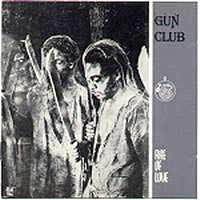 Das DebĂ¼t der Band um den charismatischen Sänger Jeffrey
Lee Pierce, produziert von Chris D. (Flesheaters) und Tito
Larriva (Del Fuegos, Tito & Tarantula) und noch ohne Kid Congo
Powers, dafĂ¼r aber mit ihrem Hit "Sex Beat" und einer
tollen Version des Robert Johnson-Klassikers "Preaching The Blues".
Das DebĂ¼t der Band um den charismatischen Sänger Jeffrey
Lee Pierce, produziert von Chris D. (Flesheaters) und Tito
Larriva (Del Fuegos, Tito & Tarantula) und noch ohne Kid Congo
Powers, dafĂ¼r aber mit ihrem Hit "Sex Beat" und einer
tollen Version des Robert Johnson-Klassikers "Preaching The Blues".

 Die
Kombination aus R&B-Piano und Gesang (Leon Russell) und Bluegrass
(New Grass Revival) klingt nicht unbedingt offensichtlich. Leon Russell,
in den späten 60ern und frĂ¼hern 70ern einer der angesagtesten
Studiomusiker in L.A. und Komponist vieler Hits (z.B. "Delta Lady"
fĂ¼r Joe Cocker) wird bei diesem Clubauftritt in Pasadena von der
angesagtesten Band der aufkommenden "New Grass"-Szene unterstĂ¼tzt:
Sam Bush (Mandoline, Geige), Curtis Burch (Gitarre, Dobro),
Courtney Johnson (Banjo) und John Cowan (Bassgitarre)
spielen zwar irgendwie Bluegrass, aber eben nicht auf die traditionelle
Weise, sondern gerne in Kombination mit Reggae, Jazz und Rock.
Die
Kombination aus R&B-Piano und Gesang (Leon Russell) und Bluegrass
(New Grass Revival) klingt nicht unbedingt offensichtlich. Leon Russell,
in den späten 60ern und frĂ¼hern 70ern einer der angesagtesten
Studiomusiker in L.A. und Komponist vieler Hits (z.B. "Delta Lady"
fĂ¼r Joe Cocker) wird bei diesem Clubauftritt in Pasadena von der
angesagtesten Band der aufkommenden "New Grass"-Szene unterstĂ¼tzt:
Sam Bush (Mandoline, Geige), Curtis Burch (Gitarre, Dobro),
Courtney Johnson (Banjo) und John Cowan (Bassgitarre)
spielen zwar irgendwie Bluegrass, aber eben nicht auf die traditionelle
Weise, sondern gerne in Kombination mit Reggae, Jazz und Rock.  Meine
erste Lee Clayton-Platte und sein letztes Studioalbum fĂ¼r eine
sehr lange Zeit. Beeindruckend die Gitarrenarbeit von Clayton, Phil
Donnelly und Tim Krekel, die nun gar nichts mehr mit dem
Ă¼blichen Nashvillesound zu tun hatte.
Meine
erste Lee Clayton-Platte und sein letztes Studioalbum fĂ¼r eine
sehr lange Zeit. Beeindruckend die Gitarrenarbeit von Clayton, Phil
Donnelly und Tim Krekel, die nun gar nichts mehr mit dem
Ă¼blichen Nashvillesound zu tun hatte.